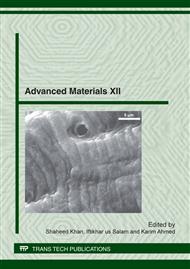p.481
p.487
p.493
p.500
p.507
p.513
p.520
p.527
p.532
Development of Fe-Cr-Co Permanent Magnets by Single Step Thermo-Magnetic Treatment
Abstract:
The present work is focused on a new approach for the development of Fe-Cr-Co based permanent magnets. Fe-Cr-Co alloy was prepared by using tri arc melting technique under inert atmosphere of Argon. Solution treatment was done at a temperature of 1250°C for five hours followed by water quenching and then a single step thermo-magnetic treatment (TMT) was applied at predetermined cooling rates. The influence of TMT and cooling rates on the final magnetic properties of the alloy were investigated. The results reveal that microstructure and magnetic properties were sensitive to both cooling rates & TMT and can be optimized by controlling the processing conditions. The optimum magnetic properties in the alloy with two different cooling rates of 1°C per minute and 2°C per minute were obtained as (i) 1010 Oe (Hc), 9400 G (Br), 3.4 MGOe (BHmax) (ii) 810 Oe (Hc), 10590 G (Br), 3.6 MGOe (BHmax) respectively. The above method provides a quick and low cost manufacturing route for the Fe-Cr-Co based permanent magnets with comparable magnetic properties to that of Alnico with added advantage of having high ductility.
Info:
Periodical:
Pages:
507-512
Citation:
Online since:
May 2012
Authors:
Keywords:
Price:
Сopyright:
© 2012 Trans Tech Publications Ltd. All Rights Reserved
Share:
Citation:


